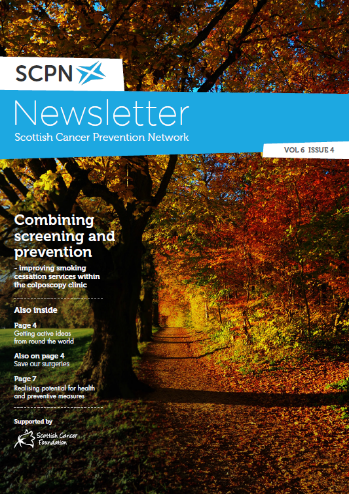
Realising potential for health and preventive measures

01 Dec 15 |
by Dr Andrew Fraser, Director of Public Health Science, NHS Health Scotland
Some food for thought for health professionals, in the quest for effective cancer prevention:
All advice and prescribing, and goals for disease management, should reflect the context in which people live.
People who face the greatest challenges in life usually have more than one risk factor to cope with. They have many. Whilst it is important that people understand the importance of taking preventive steps, the context of their lives may be such that they are unable to respond to the messages they hear; they have more immediate stresses such as lack of money or unstable relationships; and smoking, comfort eating and/or drinking may be the habit that, they perceive, gets them through. Most people aspire to improve their lot; providing a compassionate, effective service which understands the circumstances in which people live must be the starting point for considering interventions- way before agreeing goals, encouraging and monitoring progress.
Make your service attractive, and barrier-free to people who find services most difficult to reach.
We talk often about ‘hard-to-reach’ people or populations. In fact, it is the other way around. The same people find services hard to reach, for all sorts of reasons. It is for service providers to respond to the barriers that service users perceive. How long does the phone ring? How does the receptionist come across? Is the website easy to use? Are the clinic opening times suitable? Is everyone in that service sensitive to your privacy or other fears? Are other relevant services co-located in the same building or neighbourhood? Is the signposting in the right languages for all service users, or are symbols or tactile signs more appropriate? And so on.
The first 70% of people who come along to a health programme are probably the healthiest, experience fewest barriers to access, and can negotiate their way through the maze of public services that are there to support them. The last 30% find this increasingly difficult, and yet they are the ones who are the most important in terms of realising their potential for health and preventive measures. It is not their challenge; it is ours.

The SCPN Newsletter: Volume 6, Issue 4
Autumn is here and so is the SCPN newsletter! With autumn colours appearing and leaves dropping fast it is time for the final SCPN newsletter of 2015. We hope this is a read to curl up with - enjoy the latest research on cancer prevention and find out what people are doing across Scotland to spread the word about cancer prevention.